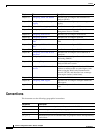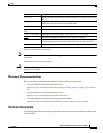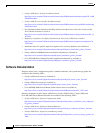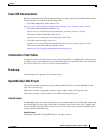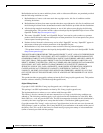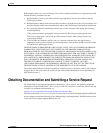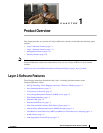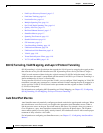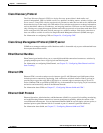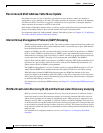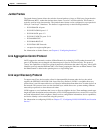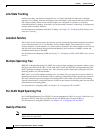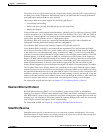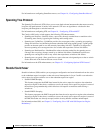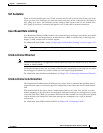
1-2
Software Configuration Guide—Release 15.0(2)SG
OL-23818-01
Chapter 1 Product Overview
Layer 2 Software Features
• Link Layer Discovery Protocol, page 1-5
• Link State Tracking, page 1-6
• Location Service, page 1-6
• Multiple Spanning Tree, page 1-6
• Per-VLAN Rapid Spanning Tree, page 1-6
• Quality of Service, page 1-6
• Resilient Ethernet Protocol, page 1-7
• SmartPort Macros, page 1-7
• Spanning Tree Protocol, page 1-8
• Stateful Switchover, page 1-8
• SVI Autostate, page 1-9
• User-Based Rate Limiting, page 1-9
• Unidirectional Ethernet, page 1-9
• Unidirectional Link Detection, page 1-9
• VLANs, page 1-10
• Virtual Switch System Client, page 1-10
• Y.1731 (AIS and RDI), page 1-10
802.1Q Tunneling, VLAN Mapping, and Layer 2 Protocol Tunneling
802.1Q tunneling is a Q-in-Q technique that expands the VLAN space by retagging the tagged packets
that enter the service provider infrastructure. 802.1Q tunneling allows service providers to assign a
VLAN to each customer without losing the original customer VLAN IDs inside the tunnel. All data
traffic that enters the tunnel is encapsulated with the tunnel VLAN ID. Layer 2 Protocol Tunneling is a
similar technique for all Layer 2 control traffic.
To map customer VLANs to service-provider VLANs, you can configure VLAN mapping (or VLAN ID
translation) on trunk ports connected to a customer network. Packets entering the port are mapped to a
service provider VLAN (S-VLAN) based on the port number and the original customer VLAN-ID
(C-VLAN) of the packet.
For information on configuring 802.1Q tunneling and VLAN Mapping, see Chapter 25, “Configuring
802.1Q Tunneling, VLAN Mapping, and Layer 2 Protocol Tunneling.”
Auto SmartPort Macros
Auto SmartPort macros dynamically configure ports based on the device type detected on the port. When
the switch detects a new device on a port it applies the appropriate Auto SmartPorts macro. When a
link-down event occurs on the port, the switch removes the macro. For example, when you connect a
Cisco IP phone to a port, Auto SmartPorts automatically applies the IP phone macro. The IP phone
macro enables quality of service (QoS), security features, and a dedicated voice VLAN to ensure proper
treatment of delay-sensitive voice traffic.
For information on configuring uto SmartPort macros, see Chapter 17, “Configuring Auto SmartPort
Macros.”



